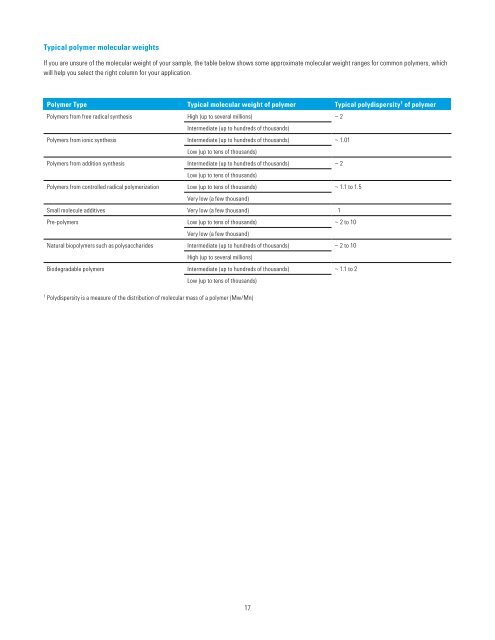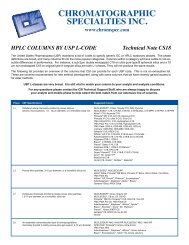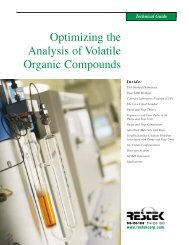You also want an ePaper? Increase the reach of your titles
YUMPU automatically turns print PDFs into web optimized ePapers that Google loves.
Typical polymer molecular weights<br />
If you are unsure of the molecular weight of your sample, the table below shows some approximate molecular weight ranges for common polymers, which<br />
will help you select the right column for your application.<br />
Polymer Type Typical molecular weight of polymer Typical polydispersity 1 of polymer<br />
Polymers from free radical synthesis High (up to several millions) ~ 2<br />
Intermediate (up to hundreds of thous<strong>and</strong>s)<br />
Polymers from ionic synthesis Intermediate (up to hundreds of thous<strong>and</strong>s) ~ 1.01<br />
Low (up to tens of thous<strong>and</strong>s)<br />
Polymers from addition synthesis Intermediate (up to hundreds of thous<strong>and</strong>s) ~ 2<br />
Low (up to tens of thous<strong>and</strong>s)<br />
Polymers from controlled radical polymerization Low (up to tens of thous<strong>and</strong>s) ~ 1.1 to 1.5<br />
Very low (a few thous<strong>and</strong>)<br />
Small molecule additives Very low (a few thous<strong>and</strong>) 1<br />
Pre-polymers Low (up to tens of thous<strong>and</strong>s) ~ 2 to 10<br />
Very low (a few thous<strong>and</strong>)<br />
Natural biopolymers such as polysaccharides Intermediate (up to hundreds of thous<strong>and</strong>s) ~ 2 to 10<br />
High (up to several millions)<br />
Biodegradable polymers Intermediate (up to hundreds of thous<strong>and</strong>s) ~ 1.1 to 2<br />
Low (up to tens of thous<strong>and</strong>s)<br />
1 Polydispersity is a measure of the distribution of molecular mass of a polymer (Mw/Mn)<br />
17











